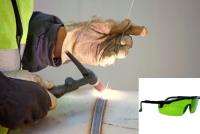 Add My Company
Add My Company
Sign In
TOP 4 WELDING MYTHS – BUSTED!
26-02-2019

Welding is a dangerous job; you are trying to control tiny lightning in order to fuse two skin-meltingly hot pieces of metal together. When you remember this, you realise that working under the influence of any myths or misinformation could be very dangerous, and maybe even lethal. Clearing up these misconceptions is an important step towards ensuring that you can enjoy stress-free welds.
1) MELTING CONTACTS
One of the scariest welding myths we have come across is that wearing contact lenses during a weld can cause the lenses to melt and fuse to the eye’s cornea, causing the wearer to go blind. Thankfully, this has been proven to be scientifically impossible.
Long before contact lenses could melt onto the surface of your eye, your skin and hair would have already started to burn, because they are more susceptible to change under heat than the plastic used in lenses. If it were true that welding could cause your skin and hair to burn away simply by being near a weld, there would be stricter safety equipment involved in welding – you wouldn’t be able to show any skin at all.
In combination with the impossibility of this myth, there have been no medically verified reports of the simple act of welding causing such tragedies. Despite the lack of facts behind this story, you should always exercise caution when engaging in welding; put safety first and make sure that you are wearing heat resistant gloves and eye protection goggles.
2) MILK BEATS FUMES
There is an old tale that milk can protect against the damaging effects of breathing in poisonous welding fumes, but this simply isn’t true. Part of the – illogical – reasoning behind welder’s milk is that milk encourages the creation of mucus in the body, which will therefore aid in the extraction of dangerous fume particles. Another suggestion was that the high-fat content in milk binds the toxins in the gut before they can do any lasting damage.
Unfortunately for those welders who have been drinking milk as a preventative measure against fume inhalation, neither of these properties have any effect on getting welding fumes out of the body. Firstly, milk is drunk whereas fumes are inhaled, so the two quickly end up in different parts of the body, making it impossible for the milk to affect the fumes, because the two don’t cross paths.
If you want to protect yourself, your employees and coworkers, you should install an effective welding fume extraction equipment.
Parweld XR640A Power Air Purifying Safety Helmet
3) YOU CAN WELD ANYTHING
Sadly, you can’t weld everything better, but there was a very funny April fools’ joke a few years ago that confused more than a handful of people. In the following video you can watch a welder’s attempt to repair a ceramic mug with a welding gun:
The video presumably makes very good use of video editing technique, because you would need a miracle and a half to restore ceramic to its original state through welding technique. For any beginners reading this article, here is a quick list of some of the types of materials that can be welded:
Steels
Stainless Steels
Aluminium and aluminium-alloys
Nickel and nickel-alloys
Copper and copper-alloys
Titanium and titanium-alloys
Cast iron.
This cool video should remind you to always question the information presented to you. A quick fact check from respectable sources will help you to debunk those little myths that might be interfering with your welding business or hobby practices.
4) WELDING IS EASY
For whatever reason, there is a misplaced theory that welding is an easy job, especially when working with MIG tools. While it might be true that anyone could learn to do a simple fuse in a couple of hours, an experienced welder will be able to ensure that their work can hold under stress, be aesthetically pleasing, and will be practised with thorough and appropriate safety measures.
Much like making sushi, a lot of hard work and training must be undertaken to be able to create high-end welding results, irrelevant of whether you are using MIG or TIG.
Whether you practice welding for work or for pleasure, make sure that you are working with the latest information and the best tools. You can purchase welding-related tools from our website, and you can find out more welding facts by checking back to our blog or reading the following posts:
The Most important Types of Welding
MIG and TIG welding; What’s the Difference?
How to Stay Safe When Gas Welding
How TIG Welding Works
Acetylene Alternative – Propylene Fuel Gas
For more information on TOP 4 WELDING MYTHS – BUSTED! talk to Adams Gas
Enquire Now
List your company on FindTheNeedle.

